FAQ
TL;DR: 3 cables at the ceiling (two 3‑core + one 2‑core) often confuse loop‑in wiring; "Two brown together and insulate." Wire the switched live to the lamp, keep permanent lives looped, and tie neutrals together to stop trips. [Elektroda, bumble, post #18047552]
Why it matters: Miswiring can leave fittings live or kill other lights; this helps UK DIYers fix a single/double switch lamp safely.
Quick Facts
- UK/EU colours: brown = live (L), blue = neutral (N), green/yellow = earth (CPC). Sleeve the switched live brown. [Electrical Safety First, 2023]
- Most domestic lighting circuits need 30 mA RCD protection due to concealed‑cable rules in BS 7671:2018+A2:2022. [IET, 2022]
- Typical UK lighting MCBs are 6 A or 10 A; keep loads and wiring sized accordingly. [IET, 2022]
- Prove dead with a GS38‑compliant two‑pole tester (e.g., Fluke T110/T130) before any work. [HSE GS38, 2015]
- Loop‑in method: join permanent lives (browns) together in a separate connector; do not feed the lamp from this join. [Elektroda, bumble, #18047552
How do I wire a new ceiling lamp with two 3‑core cables and one 2‑core switch cable?
Use the loop‑in method.
- Join the two brown permanents together in an insulated connector only.
- Join the two blue neutrals together and to the lamp neutral (N).
- Connect the red from the 2‑core (switched live return) to the lamp live (L). Join all green/yellow earths to the lamp earth terminal. [Elektroda, bumble, post #18047552]
Which wire is the switched live and where does it go?
In this setup, the red in the 2‑core to the switch is the switched live return. Connect that red to the lamp’s live (L). Keep the two brown permanent lives looped together but not on the lamp live. Join both blue neutrals together to the lamp neutral (N). Earths go to the lamp earth terminal. [Elektroda, bumble, post #18047552]
Why does the breaker/RCD trip when I flip the switch?
A miswired loop can short live to neutral through the switch wiring. If you tied the switched wire to neutral, protection will operate. As the expert warned: "You're shorting the switch." Separate the permanent lives, neutrals, and the switched live correctly as in the loop‑in method. [Elektroda, bumble, post #18047482]
Why did the kitchen lights go out when I disconnected the dining pendant?
You opened the permanent live loop. The two brown permanents feed other lights; if you separate them, downstream lights lose power. Rejoin the two browns in a separate connector and insulate. Do not connect this permanent live join to the lamp’s live terminal. [Elektroda, bocian1821, post #18047551]
Is it normal to find power‑in, power‑out, and a switch cable at the ceiling?
Yes. That is the common loop‑in method: one 3‑core brings power in, another carries power on, and a 2‑core goes to the wall switch. The lamp connects only to neutral and the switched live return from the switch. [Elektroda, bumble, post #18047387]
Do I need to connect earth to a metal light fitting?
Yes. Bond all green/yellow CPCs together and to the fitting’s earth terminal. Only double‑insulated (Class II) fittings without an earth terminal omit this. Check the Class II symbol if unsure. Maintain CPC continuity across the loop as required by BS 7671. [IET, 2022]
I don’t have a meter; can I still identify the right wires safely?
Do not guess. Isolate the circuit at the breaker, lock off if possible, and prove dead. Use a GS38‑compliant two‑pole tester to identify the permanent live loop, neutral group, and switched live. Avoid neon screwdrivers or non‑contact pens for proving dead. [HSE GS38, 2015]
What if the green/yellow conductor was used as a switch wire?
Green/yellow must only be used as a protective conductor. It cannot serve as a live, even if re‑sleeved. If a past installer used it as live, correct the wiring with an appropriate core and maintain a dedicated CPC. "Green‑and‑yellow is reserved for protective conductors." [IET, 2022]
Can I have all bulbs turn on together from one switch?
Yes. The lamp’s internal wiring usually parallels its bulbs. Connect neutral to the neutral group and the lamp live to the switched live return. Keep permanent lives looped only. Operate them from a single gang on your dual switch as desired. [Elektroda, bumble, post #18047387]
I have a double‑gang switch; how does that map to the ceiling?
Each gang switches its own switched live return. A single permanent live often feeds both gangs. At the ceiling, your lamp uses the neutral group and its own switched live (red). Keep the two browns looped together but off the lamp live. [Elektroda, bumble, post #18047552]
What connectors should I use for loop and earth joints?
Use quality lever or push‑in connectors sized for the conductors. WAGO 221 COMPACT splicing connectors handle 0.14–4 mm² and are rated up to 32 A. Place them inside a suitable enclosure or the lamp’s terminal cover. Ensure strain relief and no exposed copper. [WAGO, 2021]
What voltage should I expect when testing at the ceiling rose?
With power on and safe access, expect about 230 V AC between live and neutral. Expect 0 V between neutral and earth when correctly wired. The switched live shows 230 V only when the switch is on. Always test safely with a two‑pole tester. [IEC, 2009]
What final checks should I do before restoring power?
Perform a tug test on all connectors. Verify earth continuity from CPCs to the metal fitting. Confirm permanent lives are looped only, not on lamp L. Replace covers, energize, and test the switch. Prove the circuit dead again before any rework. [HSE GS38, 2015]
My switch does nothing and the lamp stays on. What did I miswire?
You likely connected the lamp to the permanent live loop. Move the lamp live onto the red switched return from the switch. Keep the two browns joined only to each other. Join both blues to the lamp neutral. Re‑test operation. [Elektroda, bumble, post #18047552]
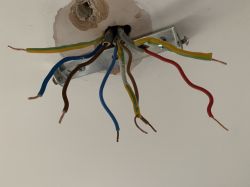
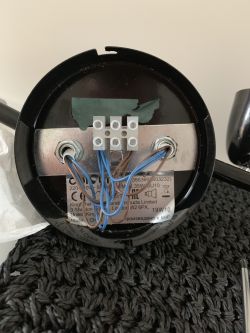





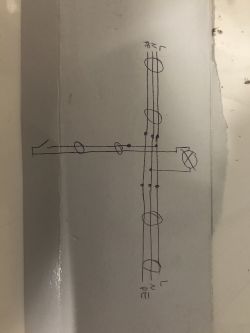
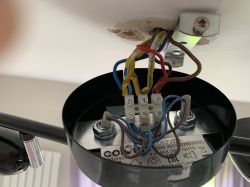
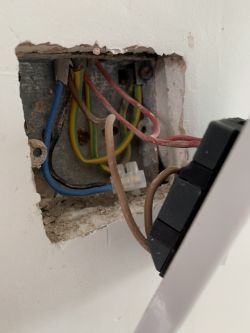

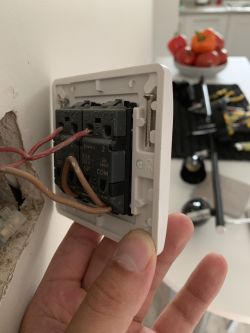
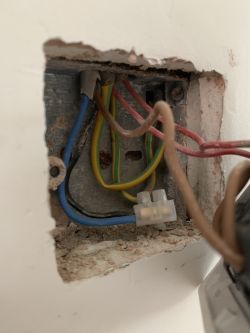
 Good luck.
Good luck.